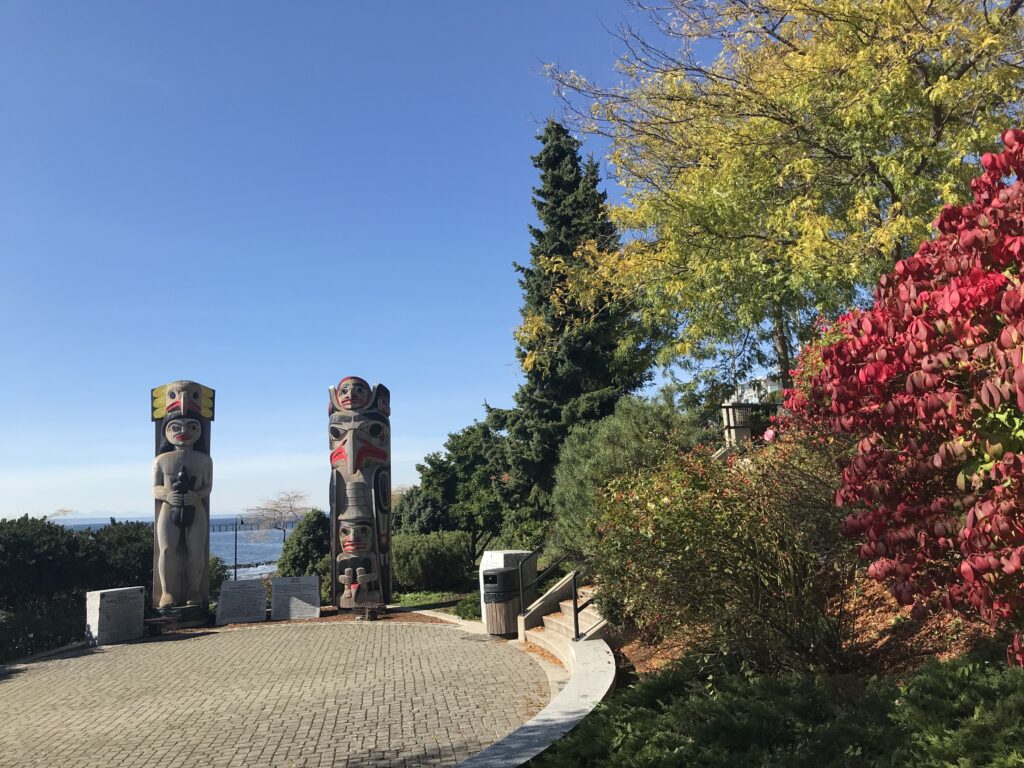We acknowledge we are on the traditional, unceded territories of the Semiahmoo First Nation and the broader territory of the Coast Salish Peoples.
If you’ve walked along East Beach, you’ve probably noticed two tall house poles in a small park along Marine Drive. You might have even seen them but wondered what they represent and the story behind the poles. Grand Chief Bernard Robert Charles Memorial Plaza within Lions Lookout Park, is centrally located along the promenade at White Rock Beach as a tribute to the Semiahmoo First Nation, as it rests on their ancestral territories.

The poles were the vision of RCMP Constable Mike Lane who “saw an opportunity to celebrate the historic 125th anniversary of the Royal Canadian Mounted Police while mending the fabrics of the cultural community of the Semiahmoo Peninsula together.” The house poles, named “The Gift” signify a partnership between the RCMP, the First Nations people and the City of White Rock. Although the relationship between the RCMP and the First Nations People has not always been a positive one, the focus of The Gift was to bridge the gap and begin healing. Haida artist Robert Davidson was commissioned by the White Rock detachment of the RCMP to create the two traditional house poles. Carved from ancient western red cedars, the poles represent both Haida and Coast Salish traditions. Davidson designed the Haida Pole and Coast Salish artist, Susan A. Point created the design for the Coast Salish House pole. On April 25, 1999, the poles were raised as a celebration, on the traditional homelands of the Semiahmoo First Nations. The Semiahmoo people blessed the site as a spiritual site, and the poles were raised according to their traditions.

The pole on the left (facing west) is the Coast Salish House pole (“Ka’Kan”). It is of great significance to the Salish beliefs and traditions of the Semiahmoo people. The house pole is rooted in the creation of the living spirit of the tree that was used to create the pole. The pole stands tall as a sign of protection and love of the creator of all living nature.
The pole on the right (facing west) is the Haida Pole (“Gya ana”). The Haida people believe a pole to be a historical document that shows the crest of the creator or tells stories that date back hundreds of years. This pole tells visitors of the Semiahmoo people who own the poles and welcomes visitors from all over the world. The poles also traditionally face the water to welcome guests coming from the Salish Sea (Georgia Strait).
Carvers: Robert Davidson, Ben Davidson, Reg Davidson, Leonard Wells, Leslie Wells and John Livingston
For more information, head down to East Beach and check the poles out yourself! You’re sure to be amazed at their size and the stories rooted within them.
The best way to get to Grand Chief Bernard Memorial Plaza is Marine Drive and turning into the parking lot at the foot of the hill separating East Beach and West Beach (across from Moby Dicks Fish & Chips).
(post written with input from the White Rock Museum & Archives).
